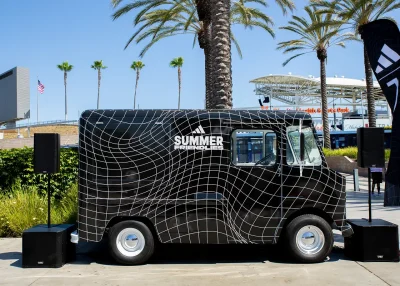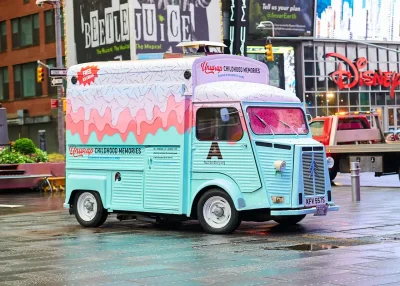
Marketing in Motion: The Rise of the Mobile Marketing Vehicle
While traditional advertising still has its place, modern brands are constantly seeking more creative and interactive ways to connect with their target audiences. Thanks to
Pop-up shops are temporary storefronts intended to establish a brick-and-mortar presence, particularly for entrepreneurs that maintain a strong digital presence through e-commerce.
They are designed to allow potential customers the opportunity to browse their goods and interact with their brand in a more intimate experience, with the intended goal of increasing awareness for their online marketplace.
While they often take the form of a temporary location chartered for a month or two, or perhaps mobile locations (such as food trucks), they also exist as promotional events which may only last a day or three.
Whatever form or duration the pop-up shop takes, they can create a unique experience for your clientele and launch your brand to new heights.
But what does it take to get started?
Not to worry– we will show you exactly how to start your own pop-up shop.
Any time you wish to begin a new endeavor, the key to its success usually lies in the preparation stage. Throwing yourself into a significant venture without a roadmap will more than likely end in disaster, so the first step involves patience.
While you may be excited to engage with your customers face to face and show them how incredible your products are, you want the pop-up shop experience to not only be successful, but to meet a specific goal. If you do not have a good idea of what that is, take the time to figure it out.
You should always have a primary goal when you are determining how to start your own pop-up shop. It is fine to have secondary goals as well, but ask yourself what it is you really hope to achieve from this experience.
Are you trying to drive traffic to your online storefront? Maybe you have an idea for a new product and you want to get feedback or test the market first. Perhaps your focus is more about the brand rather than the product – creating an incredible experience for your target clientele can help you build a positive and enduring reputation.
Then, come up with a measurable goal. That means defining some specific parameters, whether sales numbers, online customers using a special discount code received at your event, or some other collectible data, so you can evaluate whether your objective is successful.
Whatever you seek – establish that goal and then work backwards to design the ultimate shopping experience.
During the planning stages, you should also set a budget. To keep your pop up venture from spiraling out of control, decide exactly how much money you are willing to spend.
Your pop-up shop duration period and the cost of your selected venue may be the major strain on your budget, but make sure to take into account more than just your rent – consider other costs, too, such as those involving promotion, product costs, payroll, utilities, etc.
When you establish your limitations, you will know exactly what finances you have to work with so that you have a baseline to use to determine success and to mitigate risk.
Crunch the numbers and once you have a budget that works for you and your business, stick to it! However, it is not a bad idea to include a set flex budget to account for any unexpected or unplanned expenses – an emergency fund, if you will.
There are a wide variety of options available to host a pop-up shop. That means you have the opportunity to find a venue that works for you and your brand (as well as your budget). While you may have a picture of what you want your storefront to be already established, always shop around and consider the many choices at your disposal.
Some great ideas for potential pop up shops are:
Those are just a small taste of what is at your disposal. Each community offers unique opportunities and locations, so do your research and compare costs. Obviously, some events are harder on the wallet than others, but you may be able to work out a deal with site representatives that fits your budget.
Make sure to visit your pop-up space before you make a final decision on your location, as this is a crucial step in not only determining your satisfaction but also entering the next planning phase.
If you feel overwhelmed at this point, don’t worry– there are actually experts out there, such as StoreFront, who exist specifically to help you find a venue for a pop-up shop. It never hurts to consult with experts or professionals during any step of the process.
That extends to legal matters as well. Wherever you establish yourself, make sure that you possess all proper licenses and permissions before you set up! It is also in your best interest to consider insurance for your event or location because you can never anticipate everything that could go wrong, so as the saying goes: better safe than sorry.
Once you have chosen and acquired a venue, it’s time to actually figure out how to start your own pop-up shop, and that means getting everything set up on site, so you can open for business.
Remember that it’s not as easy as just showing up and moving product in, there are some considerations you need to resolve beforehand:
Keep in mind, it is never too soon to start building excitement over your newest venture. Social media is a great tool for spreading the word, whether through your personal or business accounts, or by making use of marketing tools and advertising to draw in your new audience.
This is where all your planning finally becomes reality. Using the data collected through your planning phase, bring in your team (if you have one) and start designing your look or event.
Once you have the pop-up looking stellar, it is time to make a few last decisions to ready your opening.
Your needs will fluctuate based on your location, product, and operational needs, but this guide should help ensure that you are fundamentally prepared to host your event. The rule of the day is to expect the unexpected. Have as many backup plans in place as you can to ensure that your store experience is as smooth as possible for you and your clientele.
Don’t forget, your event is a great promotional tool. Take ludicrous amounts of pictures of your brand in action!
Once your pop-up store experience comes to a close, hopefully you enjoyed a unique and valuable experience along with your new clients. Undoubtedly there were bumps along the road, but that is to be expected when you are managing an undertaking of such magnitude, especially if it is your first time.
Now that your pop-up venture has reached its conclusion, it is time to perform follow-up responsibilities.
First, make sure that you have appropriately cleaned up your pop-up location and returned any requested items or keys to their respective owners. Make sure to thank everyone involved that made this experience a reality, including your own staff and employees (or family members!).
Next, evaluate your results and data from your pop-up store and compare those toward your success metrics.
Did you achieve the goal(s) you set out to accomplish? If not, what could you have done differently to meet them?
Reflection is an important part of the process and is important so that you can learn from your mistakes, even if your project was a raving success. Take notes so that if you decide you want to repeat this experience, either in the same community or somewhere else entirely, you remember both what worked and what needs improvement.
Take the time to reach out to your clientele after the fact to offer your thanks, as well as featuring the event and positive outcomes on your social media, website, or advertising for your brand. Make use of any pictures from the event to promote your brand image and draw new customers.
Now that you know how to start your own pop-up shop, the next time will be even bigger and even better!
Here at FTP, we are pros when it comes to pop-ups! Learn more about us and how we can help you execute your pop-up shop and don’t forget to contact us to get started.

While traditional advertising still has its place, modern brands are constantly seeking more creative and interactive ways to connect with their target audiences. Thanks to

In today’s crowded marketing landscape, brands are constantly seeking ways to stand out and forge real connections with their audiences. Enter the experiential marketing vehicle

In today’s competitive landscape, brands must do more than advertise — they must be willing to connect. But what’s the best way to start that